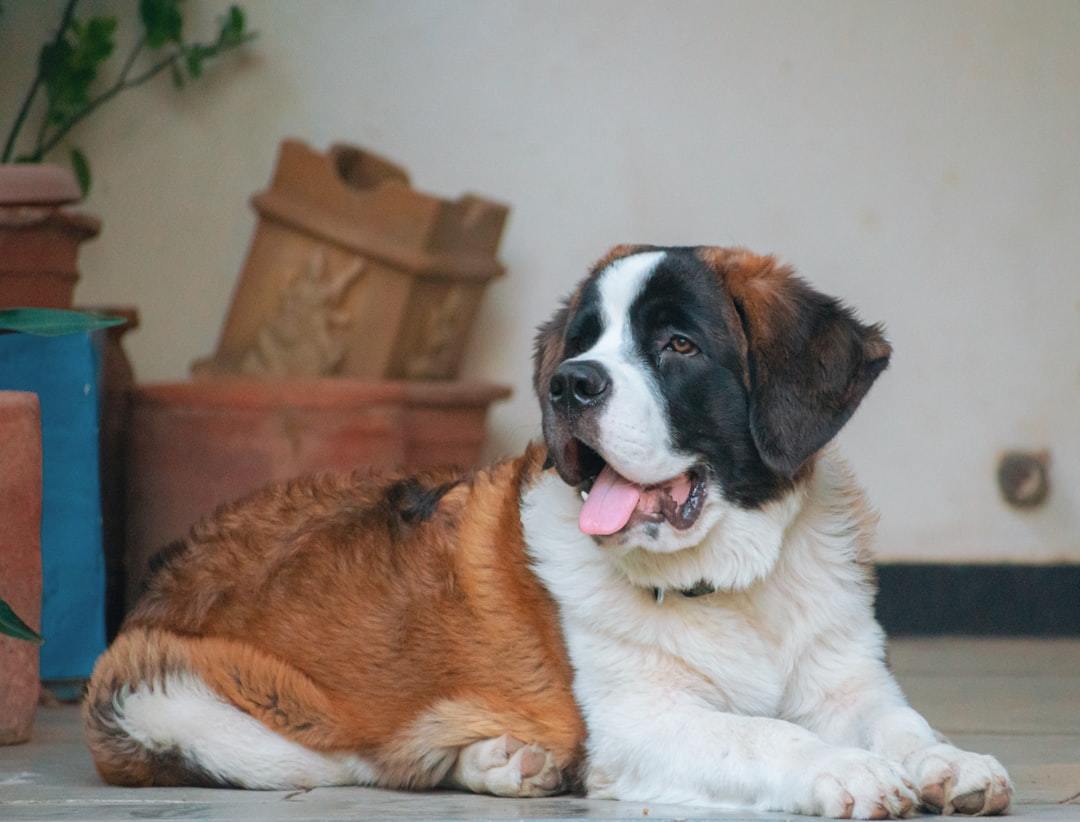St Bernard – Pros and Cons
Picture this: a gentle giant, known for its immense size and even bigger heart, the St Bernard. Not only is this breed celebrated for its heroic deeds in saving wayward souls, but it also garners much affection as a cherished companion within the homestead. Embarking on an exploration of the unique attributes and care essentials for these majestic canines ensures they thrive.
Delving into their spatial requirements, optimal nutrition for robust health, prevalent ailments to be vigilant of, and guidance on nurturing them through their golden years is our next venture. Plus, we’ll weigh the joys against the challenges of having one in your home. By the end of this read, you’ll have all you need to know about making a St Bernard part of your family or ensuring yours is as happy as can be.
Table Of Contents:
- St Bernard Variations: Understanding the Gentle Giants
- The Diet of a Saint Bernard
- Common Health Issues in Saint Bernards
- Lifespan and Aging in Saint Bernards
- Pros and Cons of Owning a Saint Bernard
- An Extra Large Family Member
 AI illustration of a St Bernard
AI illustration of a St Bernard
St Bernard Variations: Understanding the Gentle Giants
The St Bernard breed epitomizes the term “gentle giant.” Known for their massive size, calm demeanor, and iconic role as alpine rescuers, these dogs have captured the hearts of pet owners worldwide. However, not all St Bernards are created equal. This section delves into the fascinating variations within this noble breed, covering aspects such as color, size, temperament, and care-related differences.
Here’s a list of common variations you may find:
- Short-Haired (Smooth Coat): A dense, smooth coat that lies flat against the body is easier to maintain.
- Long-Haired (Rough Coat): Longer, slightly wavy, straight coat requiring more grooming.
- Red and White: The base color is white, with red markings ranging from deep mahogany to lighter orange.
- Brindle and White: Brindle markings instead of solid red patches are less common.
- Mantle (or Blanket): Large, dark patch over the back and sides, with a primarily white body.
- Dry Mouth: Variation with less drooling tendency due to a tighter fit of the lips and jowls.
- Wet Mouth: More traditional, with looser jowls leading to more drooling.
- Temperament Variation: Some individuals may be more active, while others are more laid back, though generally gentle and friendly.
Some less common variations include:
- Blue Eyes: Rare and distinctive, providing a striking contrast to their coat.
- Exceptional Size: Either larger or smaller than average, admired for rarity.
- Extraordinarily Long Hair: Longer than typical for the breed, appreciated for its beauty.
- Unique Markings: Uncommon facial or body markings that stand out.
- Short Tail: A less common feature that can be seen as a cute anomaly.
- All-White or Predominantly Dark Coats: Rare color variations that capture attention.
Color Varieties in St Bernards
The coat of a St Bernard can come in several shades and patterns. Predominantly seen colors include white with red or mahogany markings. The distribution of these markings can vary significantly from one dog to another—some may have large patches over their bodies while others sport more minimalistic looks with smaller spots and splashes.
Differing Sizes Amongst Saints
While universally recognized for their large stature, there’s still considerable variation in size among individual St Bernards. Males typically weigh between 140 to 180 pounds (63 to 82 kilograms), whereas females are slightly smaller at 120 to 140 pounds (54 to 63 kilograms). Height at the shoulders can range from about 26 inches (66 cm) up to an impressive 30 inches (76 cm) or more.
Variation in Temperament
All St Bernards share a reputation for being gentle and patient, but don’t be fooled into thinking they’re all exactly alike personality-wise! Some may display a more playful nature, while others could lean towards being laid-back couch potatoes. Early socialization plays a crucial role in shaping their temperaments; hence, adopting parents should engage them with various experiences early on.
Care Considerations Across Different Types
- Grooming Needs: Depending on whether your Saint has a short-haired or long-haired coat, it will drastically change its grooming requirements. Long-haired variants need frequent brushing to prevent matting.
- Dietary Requirements: Given their vast differences in size even within the same breed, dietary needs can vary greatly among individual Saints.
- Exercise Needs: Despite their size suggesting otherwise, some might require more daily exercise than most would expect.
As you delve deeper into understanding these majestic creatures’ varied facets, remember that each comes with unique challenges and joys. Whether you’re drawn by specific physical characteristics like coat type or looking for certain temperamental traits, knowing about these variations will help ensure your new furry friend fits well within your lifestyle.
Space: A Room to Roam
Saint Bernards are gentle giants with hearts as big as their bodies. These gentle giants crave room to extend their lengthy limbs, making confined spaces feel quite restrictive. An apartment might feel tight, so aim for a home with ample yard space. This doesn’t mean they’re outdoor dogs; they also cherish being part of the family indoors.
Fencing is crucial because these explorers will wander off following an intriguing scent trail if given half a chance.
Temperature: Keeping Cool
Their thick fur coat isn’t just for show; it keeps them warm in cold climates but can be a burden during summer months. Ensure your furry friend can access shaded areas and stay hydrated to beat the heat.
A climate-controlled environment inside helps maintain their comfort year-round, avoiding overheating, which can lead to health issues.
The Diet of a Saint Bernard
Feeding a Saint Bernard is like fueling a gentle giant. These canines require a carefully calibrated diet to maintain their colossal form in motion without accruing extra weight.
Daily Calorie Intake
Saint Bernards, with their towering presence, have dietary needs that might surprise you. Despite their size, overfeeding can lead to obesity and health issues. An adult typically requires around 2200-2500 calories daily, which varies based on activity level and age.
To find the sweet spot for your dog’s daily intake, consult your vet and adjust as needed. Remember, more exercise means they might need extra fuel.
Preferred Diet Types
Eating a diet loaded with high-quality proteins is crucial for preserving muscle and avoiding unnecessary fat accumulation. Look for foods specifically formulated for large breeds; these usually hit the right nutritional mark.
Some pet parents are drawn to raw feeding, believing it enhances their furry friends’ coat glossiness and digestive health. However, it’s crucial to research thoroughly or consult with a veterinarian before drastically changing your pet’s diet.
Amazon has a wide variety of food choices.
Common Health Issues in Saint Bernards
Saint Bernards are gentle giants with hearts as big as their size but are not immune to health issues. Recognizing these early can make a world of difference.
Hip Dysplasia
Hip Dysplasia sneaks into your Saint Bernard’s life, much like an uninvited party crasher, bringing discomfort and hindering their freedom to move easily. It’s caused by a malformation in the hip joint, leading to arthritis or lameness. Keeping them at a healthy weight and having regular vet check-ups are your best defense against this intruder.
For more insights on managing hip dysplasia, visiting reputable sites such as AKC’s guide on hip dysplasia can provide valuable information.
Bloat (Gastric Torsion)
Imagine blowing up a balloon and then twisting it – that’s similar to what happens during bloat. In this dire scenario, quick action to get your dog to a vet is critical for their survival. Preventing it involves feeding smaller meals throughout the day rather than one large meal.
Detailed prevention tips can be found through resources like VCA Hospitals’ article on bloat prevention.
If you have questions about the health of your St. Bernard, you can sign up for an online vet consultation with Ask A Veterinarian. They are available 24/7 to answer questions.
To avoid unexpected health costs, check out Pet Assure Mint.
Lifespan and Aging in Saint Bernards
Wondering how long your gentle giant might grace your life? The average lifespan of a Saint Bernard ranges from 8 to 10 years. While this may seem short, especially when you’ve fallen head over heels for their slobbery kisses and bear-like hugs, understanding what affects their longevity can help you maximize every moment together.
Factors Influencing Longevity
A few key elements affect how long these lovable giants live. First, genetics plays a role; some lines tend to live longer than others. But it’s not all in the DNA—lifestyle choices make a huge difference, too. Keeping your Saint Bernard at a healthy weight is crucial since obesity can lead to a host of health issues like heart disease and diabetes, which can shave precious years off their lives.
Regular exercise tailored to their size (think leisurely walks rather than marathon training sessions) keeps them fit without putting undue stress on their joints. Speaking of joints, another common issue that can affect longevity is hip dysplasia—a condition well-known in large breeds. Early detection through regular vet check-ups helps manage this condition before it becomes debilitating.
Pros and Cons of Owning a Saint Bernard
Owning a Saint Bernard is like having your very own gentle giant. They bring warmth, protection, and boundless love to any home they enter. But let’s be real; it’s not all belly rubs and slobbery kisses. However, one must ponder a few matters before adding one of these companions to your household.
The Bright Side: Joyful Giants in Your Home
Saint Bernards have hearts as big as their size. Their loyalty knows no bounds, making them fantastic family pets that adore children. If you’re looking for a conversation starter or an Instagram star, these dogs have covered you with their majestic appearance and often comical antics.
But there’s more than just fun when it comes to these furry friends. Moreover, their formidable appearance alone is often enough to discourage any unwelcome guests from coming too close.
The Flip Side: A Big Commitment
Now, onto the challenges – think space requirements, drool cleanup duty, and potential health issues like hip dysplasia, which can lead to costly vet bills over time, according to the AKC. And don’t forget about the grooming. Those thick coats need regular maintenance to keep them looking sharp (and your house free of fur tumbleweeds).
In summary? A Saint Bernard brings immense joy but also requires a significant commitment from its human companions.
An Extra Large Family Member
So, you’ve explored the vast world of owning a St Bernard. You know they need space to thrive and the right diet to stay healthy. But that’s not all.
You understand their health issues and how vital regular vet check-ups are. And as they age, you’re ready with tips for care.
Owning one is a joy, yet it comes with its challenges. Remember this: A happy Saint Bernard means a happy home.
In conclusion, nurturing these massive companions requires dedication but blesses you with unparalleled devotion and affection. Embark on this adventure armed with patience and a heart full of understanding.


Comments are closed.